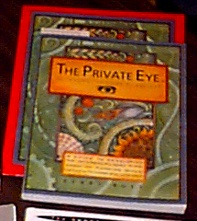

This topic should really be placed under "some of our favorite curriculum",
but we have so thoroughly enjoyed this book that The Private Eye
deserves its own section. (An ulterior motive is that every time I mention
it, and someone wants to know more about it, I can send them here! )
I was first drawn to this item in my catalogs simply because of its name
- The Private Eye. Michael enjoys mysteries and detectives, so I
thought this might be something for him. As I read about the program, I
thought it sounded very interesting. I had been wanting something to develop
thinking skills and this seemed as though it would do that - and more!
The book is not a textbook. There are no pages to fill out. It is 221 pages
jam-packed with information and ideas. We've only touched the tip of the
iceberg with what Kerry Ruef (the author) has suggested. There are activities
across the curriculum, which I'll tell about in a bit.
You use a jeweler's 5x loupe with the program. This is how you view the
world close-up! The ones that you can buy for the program are the ones that
you can tuck into your eye socket, which then enables you to have both hands
free. We purchased two of the loupes (one for each of us), but we also have
a 10x jeweler's loupe that we use most often. The book indicates that you
can nestle two 5x loupes to get a 10x magnification as well.
The book walks you through a step-by-step process of using the loupes and
asking questions to start the thinking process. As you look at an object
through the loupe, you ask, "What else does it remind me of?",
"What else does it look like?" "Why did it remind
me of that?" There are no wrong answers! We should not tell
our children that one analogy is better than another.
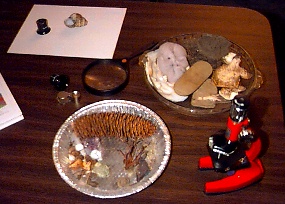
An excerpt from the book - The tone to take is "Hmmm
... I wonder why I thought that? Why it reminded me of that?"
An example is in the student who was loupe-looking at a skinny, long-legged
crane fly, the kind of insect many of us call "mosquito eaters."
(They bumble about indoors in late summer.) The student wrote of the crane
fly: like a china vase. "Well, hmmm ... why did it remind me
of a china vase?" (Since it doesn't look like a china vase.)
He thought and wrote: "as delicate as a china vase."
You use analogies to develop creativity and thinking skills.
After you have listed five to ten analogies, then you draw the item, or
an area of the item, as seen through the loop.
I purchased a NoteSketch book (Rainbow Resource) which has white space in
the upper part of the page, lines for writing in the lower part.
Here was Michael's first attempt at a "look-draw" (as we call
them):
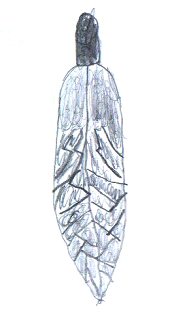
What is it like?
- It's like a watermelon. It has the same shape, and a watermelon also has
bruises. A watermelon has a stub at the end where it was picked. Some watermelons
feel squishy, too - it means they are rotten or ripe.
- It's like an ant's body. Or a grasshopper's body. All you need to do is
attach some legs and eyes.
- It's like the human skin. The skin on this pod is just as crackly as ours
is.
Why is it like this?
- Not ready to bloom yet. It's a bud.
- So the flower inside can be protected.
What will be in the pod?
- Parts of a flower
- Maybe some sticky stuff
What was found?
- "The pollen things! The pollen things!"
- Stringy things
- Beautiful leaves - they're yellow and green
- A pod in the middle
- "In the pod is seeds!"
- It's sticky where the seeds are.
- The bottom of the petals are hard.
As we did "look-draw" more often, we started to get the hang of
it! Here are a few more of Michael's. I don't have them all dated, but the
ones I've chosen to show are placed here in the order they were done.

Looks hard in the middle.
The middle looks like a hole like a cave entrance.
Some bumps are white, some are transparent.
They look dry.
The look like mountains.
You would feel bumps if you were on them on a four-wheeler!
They look like planet craters.
They look like bubbles.
Humps like on speed bumps.
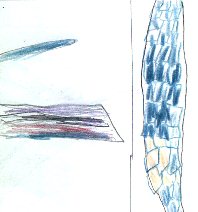
Tail (on left):
smooth like hair
like fibers on a smooth blanket
silk! silk!
like a river flowing nice and smooth
beautiful colors like God
Scales (on right):
scales like a mermaid tail
scales like a dragon
shines like glitter
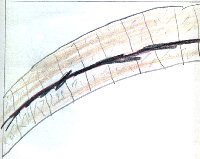
smooth like snakeskin
veins like in your own body
rings like on a dinosaur bone
eyes like tiny chunks of dirt
moves like a sidewinder
transparent like my wart
bristles that tingle like a tickle
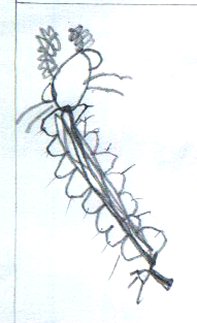
"Gross!"
No legs like a baby tadpole
black stripe down his body
two bulging eyes back on its head like a fish
pinchers on sides of mouth like an ant
transparent, like a ghost with pinchers
"It's Awesome!"
hairs that look sharp - on feelers
swims like a shrimp
body like a worm
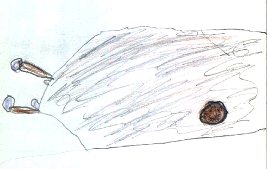
"Ugly!"
"Cool!"
marked like wet tree bark
marked like an armadillo's leg
crackly like elephant's skin
slime is like glue
head like Loch Ness Monster
moves pretty fast - doesn't actually go slow
has a gash in its side - like a blow hole
leaving a trail of slime
estimate 2" long
can retract his feelers
eyes on the end of his feelers
can move skin around
skin like protective armor
glue bubbles up (slime)
skin looks like bricks in a wall
groove like a ditch on underside
skin is like a soft shell that protects him
(Michael was so into this slug "look-draw," he gave more observations
than analogies. That's ok! It was fascinating to observe this critter!)
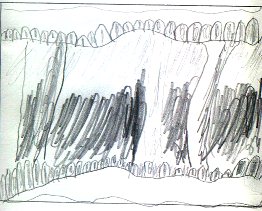
stinks like cut grass
chambers like a honey comb
scratchy like a Scotch Brite pad
patterned like a basket
hypothesis: made of mud, bark and dry grass
nest has five layers
hypothesis: dark brown things are dead flies - "the catch of
the day"
average four chambers to an inch
humps with hair
like a deep hole
chambers are not circles - hexagons
hypothesis: water will dissolve it, break it apart
Let me interject here that I write down all of the observations that Michael
makes as he is making them. I later transfer his comments/observations/
analogies into his book. After he has made all of his comments and analogies,
he then draws the item (or a portion of the item) into his book. I usually
make a 4" or 5" square on the page for him to draw in. As he is
drawing, I then read to him about the item he has just observed.
The most awesome book for reading about these items is Anna Botsford Comstock's,
Handbook of Nature Study. It is a one-stop wealth of information!
If the item we are observing is in her book, that's all we need to know
for the moment! For instance, Michael found out that he was wrong about
what the nest was made from. "The nest is of paper made of bits of
wood which the wasps pull off with their jaws from weather-worn fences or
boards. This wood is reduced to a pulp by saliva which is secreted from
the wasp's mouth, and is laid on in little layers which can be easily seen
by examining the outside of the nest." The dark brown things were not
dead flies, but more likely shed larva skin or waste material. We finished
this observation by putting a section of the nest in water to see if it
would dissolve. It did not! We also tried to light it with a match. It resisted
fire and would not ignite! The entire experience was very enjoyable!
Here is one more:
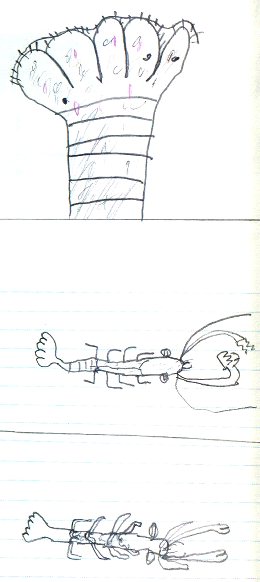
analogies:
large scales like armor
furry legs like a spider
fins like a whale
antennae like ants
claws like a lobster
tail like the shape of a sea shell
tail can fold up like a hand of cards
jaws underneath like an ant
observations:
very tense, he will grab the poker
didn't want the worm
may be hurtful to other animals, but it doesn't hurt a human
moves backwards
little claw on the bottom
body slippery, slimy
very acrobatic
feelers are bendable
very transparent skin on end of the tail
all the meat is in the tail
I want to help Michael to be more expressive in his analogies. Rather than
to compare only to other items, I want to encourage him to make comparisons
to the activities, movements, or feelings of the other items. He has made
some analogies like this ... the fish "a river flowing nice and smooth",
and a mushroom "like a storm coming, billowing clouds." I hope
to help him develop more expressive thought by using this book.
Now, back to the book!
The first part of the book gives information to use the process - exploring,
writing analogies, drawing, theorizing, thinking.
There is also a section on gathering your materials. Suggestions for collections,
how to preserve bugs (our freezer had loads of them last fall!), and making
museums.
The book then goes on to talk about using the process across the curriculum
- Go Loupe Crazy!! Writing, Art, Math, Science, Social Studies!!
Writing - There are pages and pages of writing ideas. There is a
36-week plan. Ideas for a portfolio, journal, diary, or box. Turning your
analogies into POEMS!! This will be our next step! Your child looks at their
five to ten analogies, chooses the ones he/she likes the best and uses these
analogies as "bones for poems." Here is an example from a 3rd
grader:
Seahorses
Like spines on a blackberry bush,
cobwebs in a cave of bats,
like a swiggily lizard smoking a cigar,
like the skeleton of a giraffe.
Seahorses
Art - You are drawing with each time you "look-draw." But
there is so much more! You draw to scale. Use your fingerprint as the basis
for a full page maze. They include drawing tips. Loads of ideas.
Science - What needs to be said here?! Michael and I are utilizing
science every time we "look-draw." Once again, there are pages
and pages of ideas and activities.
Math - Measurements, geometry in nature, working to scale (design
a four-foot dandelion), estimation (how many seeds in one foxglove plant),
ratios, symmetry, Escher, tessellations, and so much more!
Social Sciences - Ideas such as to choose foods from another country
that you are studying, dissect them and look-draw. Using loupes on detailed
maps, finding geographical patterns on maps. And, of course, so much more!
The book ends with an assessment section, 28 reasons to use the Private
Eye, and a bibliography and book list.

I don't believe I mentioned it, but we have a nice set
of dissection tools that aid us in exploring/examining the items (I forgot
to put them in the earlier picture!). Many times we use our 50x microscopes
in addition to the loupes. We also have a neat book from The Shooting Star
Press, Science Through the Microscope, which has wonderful pictures
of items VERY close up!
We are certainly used to looking at the world by using only our eyes. Michael
and I are just starting to scratch the surface of that incredible and beautiful
part of the world God made that can only be seen with the help of magnification.
Each time I look through this book, I get excited again at all the wonderfully
creative things we can, and hopefully will, do!
The Private Eye Website! http://www.the-private-eye.com/ruef/html/home.htm
Great Christian Books - 1-800-775-5422
Rainbow Resource - 309-937-3385
Go back to see what else I have on my web
pages...![]()
Return to our home page...![]()